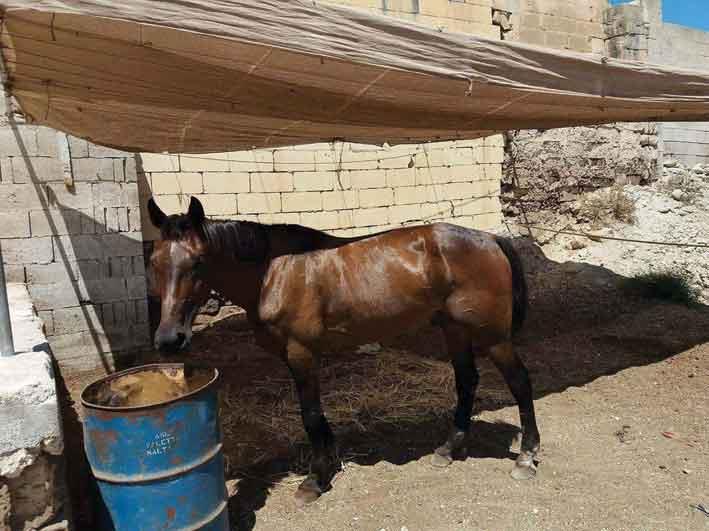While horse-drawn carriages (karozzin) have attracted some of the worst publicity of all Maltese traditions, The Malta Independent on Sunday has investigated how most of the men who operate such services treat their livelihood/hefty investments – and it is not what most people expect.
Karozzini are often subject to petitions calling for a ban on the practice, with people enraged by what they claim is the appalling and troubling conditions with which the horses have to contend. One of the main complaints by members of the public is that the horses are left out in the sun all day, or that they are made to pull around the carriage plus four people and the owner on the tours provided.
Arguments against the practice are shared and spread widely – from conversations on popular local social media pages, outraged descriptions accompanying petitions, ‘letters to the editor’ submitted to newspapers and much more. What we rarely see or hear from, however, are the owners of the horses and karozzin and their version of events.
Preferring to remain anonymous, many of the men who appear on the streets of Valletta, Rabat and other popular tourist areas described how each owner has a minimum of three horses, while some have up to five.
This means that the horses are rotated so that they each have a minimum of two rest days a week. Another myth about the length of time horses are made to wait outside for possible passengers has also been debunked. The horses do not endure any 12-hour ‘shifts’, so to speak, but one owner said that if a horse is taken out in the morning with its carriage, it would be back in its stable safe and sound by early afternoon.

Not all the owners of karozzini ensure high standards and a good quality of care, with the law courts having investigated and convicted some owners whose horses were in poor condition, mainly due to dehydration.
Back in 2013, Carmel Mallia was fined €2,000 after police were alerted to a distressing scene when his horse had collapsed due to dehydration at the side of a road in Pietà. A vet who was called ultimately decided to put the horse down due to the considerable pain it was suffering, and after a pipe inserted into its stomach found only dry food and no fluids.
The courts took action and the owner was fined. More recently, in April 2016, a man was filmed whipping a horse that had fallen over. This footage was shared many times on social media, with hundreds of people expressing disgust and outrage as to why the owner would be hitting its horse. The man was arrested and investigated.
When the footage emerged, this newsroom spoke to various horse enthusiasts and specialists, and was told that this is often a last resort to try to get a horse back on its legs when a person is alone and obviously does not have the strength to try and physically lift the horse. While the merits of that particular case remain to be seen, one particular horse enthusiast cautioned against jumping to conclusions in some cases.
The owners stressed that the most important aspect in their view is the enforcement of existing laws so that serious action is taken when a horse is dehydrated or made to work when it is obviously suffering. It was repeatedly stated that the vast majority of horses are not dehydrated and are looked after properly.

This newsroom’s strong animal welfare stance made it somewhat difficult to broach the story, but RMJ Horse Rescue founder Korin Farrugia stressed that, overall, the vast majority of horses used with the traditional Maltese karozzini are well cared for and are in a much better condition than the horses she comes across in her rescue work.
She explained that, in her opinion, most of the karozzini owners tend to have a bad reputation and that, often enough, photographs on social media of horses standing out in the sun give a worse impression than is actually the case.
One issue that would certainly improve the situation is the provision of shelters in certain areas, such as by the cruise liner terminal in Valletta. Some karozzin owners report that they have even offered to pay for an extra shelter themselves, but have yet to receive a reply.
Farrugia described to this newsroom how cooperation between Rabat local council and the karozzin owners has resulted in an ideal situation, with permanent shelters and water access points so that all the horses can wait in the shade. The parking of cars under these shelters continues – to the detriment of the horses and despite the owners calling the police who then issue fines. The owners say that some people never learn.
“What is important is that the horses are well cared for and maintained in good condition so they can do their work comfortably. The general appearance of most karozzin horses does, in fact, show that they are well looked after and are capable of undertaking the workload – because otherwise they would not be in that condition. In fact the karozzin mare that we took in recently was not managing to cope physically with her workload so began looking in poor condition. The owner didn’t want to keep working her so he retired her with us,” she Farrugia.
This newsroom is informed that every year the horses must be certified as being healthy by a veterinary surgeon and that while there are some rogue owners who do abuse their horses – and any such abuse should be reported so that the appropriate action can be taken – many ensure that their €250,000 investment is in good condition.
From a horse-rescue perspective, Farrugia explained that many of the horses used for the karozzin are ex-racehorses that would probably be put down after their racing days are over.